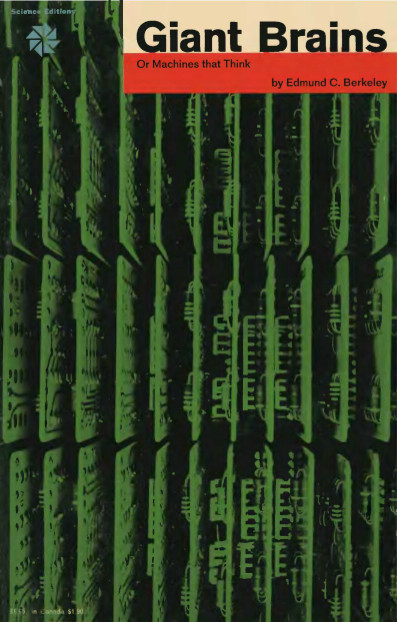Dorothy Stein: Ada: A Life and a Legacy (1987)
Filed under book | Tags: · biography, computing, electricity, history of computing, history of science, mathematics, science, technology

In this engrossing biography, Dorothy Stein strips away the many layers of myth surrounding Ada Lovelace’s reputation as the inventor of the science of computer programming to reveal a story far more dramatic and fascinating than previous accounts have indicated. Working with original sources, Stein clears up a number of puzzles and misinterpretations of Ada’s life and activities.
Augusta Ada Byron, Countess of Lovelace, was the only daughter of the poet Lord Byron and the close friend and associate of a number of the foremost scientific, literary, and artistic figures of the early Victorian period. She enjoys a growing reputation today for her report on Charles Babbage’s Analytical Engine—considered to be the first computer. Yet Stein shows how the often self-serving Babbage conspired to create the legend, using the Countess to promote his projects and make exaggerated claims for his engine. By placing Lady Lovelace’s report in the social and cultural context in which it was written, she finds that, far from being a clear and masterly exposition of the structure and logic of the computer, it was a rather mystical tract that dwelt on the inventor’s outdated philosophy of mathematics, and his mechanistic view of theology and the workings of capitalist economics.
Ada’s own life is vividly told, often in her own words, as Stein weaves into her narrative excerpts from letters, memoirs, and little-known documents to create an account that is at once black comedy, detective story, psychological drama, and scientific explanation. She examines the barriers and opportunities that Ada faced as she strove to develop her ambitions and search for truths that would free her of that shadow of her mysterious father and her overbearing and manipulative mother.
Stein reveals a turbulent and complex woman who tries to run away, who marries and bears three children, attempts to bury herself in the study of mathematics, and to find herself in a career in music or in writing. Ada corresponds and associates with men as diverse as Dickens, Chadwick, Quetelet, and Wheatstone. She sickens and attempts to find the cause of her malady by exploring the fringes of several sciences. Her interest in the use of electricity to treat nervous disorders involves her in the controversies over mesmerism and phrenology, and turns her from Babbage to Faraday and to Andrew Crosse, the “electrician” whose work served as the model for Frankenstein. With Ada, Stein examines the roots of the fear, fascination, and mystic awe with which we still regard the impact of high technology upon ordinary life.
Publisher MIT Press, 1987
History of Computing Series
ISBN 0262691167, 9780262691161
321 pages
Jon Gernter: The Idea Factory: Bell Labs and the Great Age of American Innovation (2012)
Filed under book | Tags: · communication technology, computing, engineering, history of communications, history of computing, history of technology, networks, radio, technology, telephone

“High-handed corporate monopoly and high-minded national treasure, the American Telephone and Telegraph Company (AT&T) was a unique project of America’s pragmatism and for decades the envy of the world in extending low-cost local telephone service. At the heart of AT&T was its R&D unit, Bell Laboratories, the world’s greatest entity of its kind, and a giant manufacturing arm, Western Electric.
The Idea Factory is the first study of Bell Labs that puts its history in its full organizational, political, and administrative context. AT&T was a company striving to expand and maintain a privileged empire under a government that saw it alternatively as a trusted military/industrial partner and an anticompetitive threat. This ambiguous embrace, New York Times Magazine writer Jon Gertner suggests, inadvertently encouraged a culture that combined a gifted and diverse workforce with a long-term outlook, creating the foundations of a new information economy, which in turn made radical changes in the charter of the parent company inevitable.
Gertner’s story is the interaction between three leaders of Bell Labs in its critical years—Mervin Kelly, Jim Fisk, and William Oliver Baker—and three of its greatest scientific minds: William Shockley, Claude Shannon, and John Pierce.” (from a review by Edward Tenner)
Publisher The Penguin Press, New York, 2012
ISBN 1594203288, 9781594203282
422 pages
via Steve McLaughlin
review (Edward Tenner, Issues in Science and Technology)
review (Dave Tompkins, Slate)
review (Jesse Hicks, The Verge)
PDF (EPUB, updated on 2013-5-7)
PDF (MOBI, updated on 2013-5-7)
Edmund C. Berkeley: Giant Brains, or Machines That Think (1949/1961)
Filed under book | Tags: · computing, cybernetics, machine

Giant Brains is one of the first books on electronic computers for a general audience.
In it, the co-founder Association for Computing Machinery (ACM) Edmund Berkeley described the principles behind computing machines (called then “mechanical brains”, “sequence-controlled calculators”, or various other terms), and then gave a technical but accessible survey of the most prominent examples of the time, including machines from MIT, Harvard, the Moore School, Bell Laboratories, and elsewhere.
Originally published by Wiley & Sons, 1949
Publisher Science Editions, New York, 1961
292 pages

